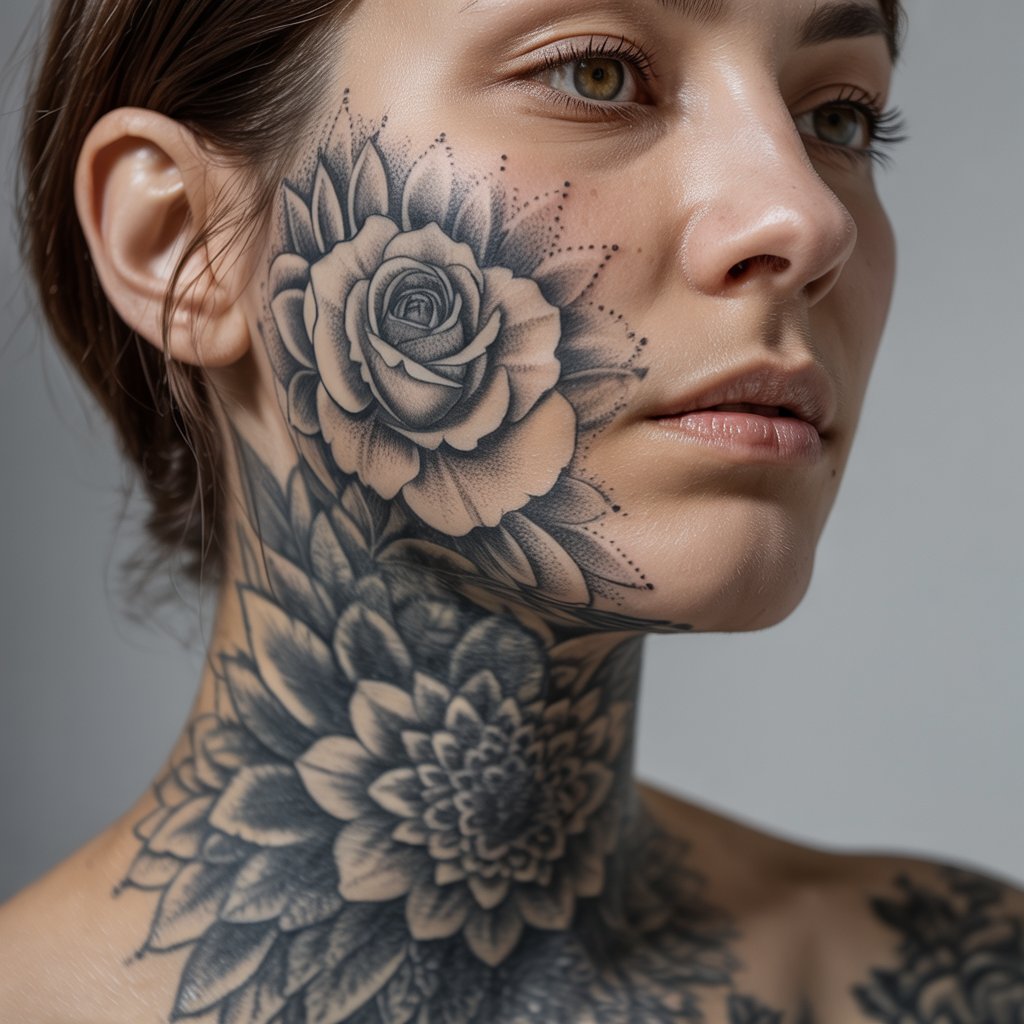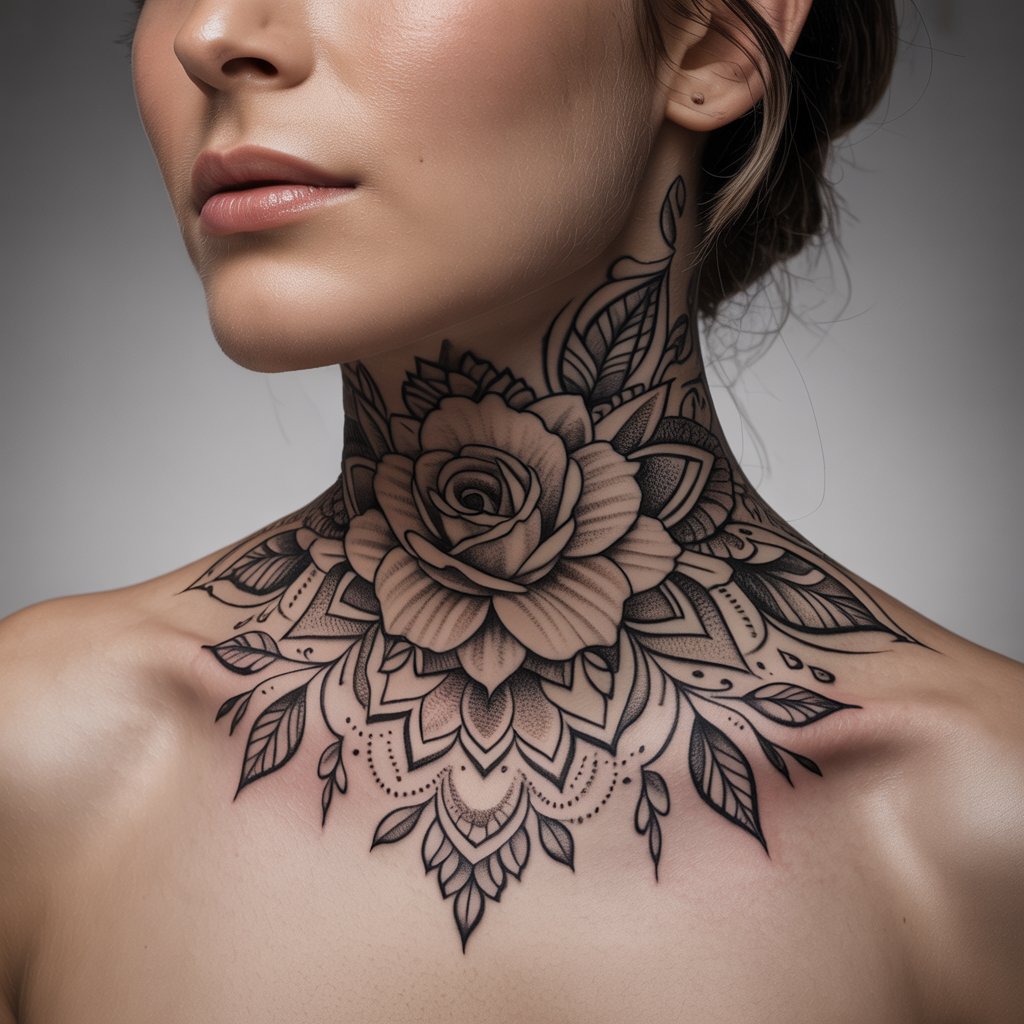In the evolving landscape of body art, throat tattoos have emerged as one of the most striking and significant expressions of personal identity. These elaborate designs—often featuring intricate florals, mandalas, and geometric patterns—have transformed from a niche art form to a powerful statement of self-expression that captivates both the wearer and observer.
The Aesthetic Revolution
The modern throat tattoo represents a remarkable fusion of traditional tattoo art with contemporary design sensibilities. Unlike the simple symbols or text that once dominated this placement, today’s throat pieces often feature:
- Photorealistic central elements (particularly roses and other florals)
- Mandala-inspired geometric frameworks
- Dotwork and fine line techniques
- Harmonious integration with the neck’s natural contours
- Balanced symmetry that enhances facial features
“The throat canvas demands exceptional technical skill,” explains renowned tattoo artist Mira Kaplan. “The skin texture varies significantly across this area, and the curvature requires designs that complement the natural anatomy rather than fight against it.”
Beyond Beauty: The Psychological Dimension
Choosing to adorn one’s throat with permanent art carries profound psychological significance. The throat is both physically vulnerable and visually prominent—making it one of the most intimate yet public spaces for artistic expression.
“When someone chooses a throat tattoo, they’re making a statement about transparency and authenticity,” notes cultural anthropologist Dr. James Wei. “There’s something powerfully honest about placing art in a location that cannot be hidden in everyday life.”
This permanent visibility reflects a commitment to living authentically, without compartmentalizing different aspects of one’s identity. In professional settings, social interactions, and intimate relationships, the throat tattoo remains constantly present—a testament to the wearer’s dedication to their chosen aesthetic and personal journey.
The Technical Artistry
Creating exceptional throat tattoos requires specialized knowledge and skills that go beyond standard tattooing techniques:
- Anatomical considerations: Artists must account for the throat’s natural movement, speech patterns, and complex underlying structure
- Pain management: As one of the more sensitive areas of the body, sessions often require careful pacing and breaks
- Aging adaptations: Designs must anticipate how the skin will change over time, with elements that will remain coherent even as lines naturally soften
- Complementary composition: Thoughtful artists consider how the design enhances rather than competes with facial features
“The most successful throat pieces create visual harmony between the face and body,” notes tattoo historian Elena Sanchez. “They should feel like they’ve always been there—an extension of the person’s natural beauty rather than something imposed upon it.”

Cultural Context and Shifting Perceptions
The increasing popularity of throat tattoos signals a broader cultural shift around self-expression and professional identity. What was once considered strictly countercultural has found its way into mainstream aesthetics, challenging conventional boundaries between personal expression and professional presentation.
This evolution reflects larger societal movements toward authenticity and self-determination. As remote work, creative industries, and entrepreneurship reshape traditional workplace norms, visible body art has become increasingly accepted across various professional contexts.
Considerations Before Commitment
For those contemplating a throat tattoo, several important factors deserve careful consideration:
- Professional implications: Despite changing attitudes, some career paths may still present challenges for those with highly visible tattoos
- Artist selection: This placement demands exceptional skill—research thoroughly and choose artists with extensive throat tattoo portfolios
- Design longevity: Consider how the design will age both aesthetically and personally
- Session preparation: Throat tattoos typically require multiple sessions with adequate healing time between appointments
- Aftercare requirements: The throat’s frequent movement necessitates particularly diligent aftercare during healing
A Timeless Statement in an Evolving Art Form
As body art continues to evolve, throat tattoos stand as powerful testaments to the medium’s artistic potential. These designs transform one of the body’s most visible and vulnerable spaces into a canvas for extraordinary personal expression—merging technical precision with profound meaning.
For those who choose this path, the throat tattoo becomes more than decoration—it becomes an integral part of how they present themselves to the world, a daily reminder of their commitment to authenticity, and a celebration of the body as a living canvas for exceptional art.


